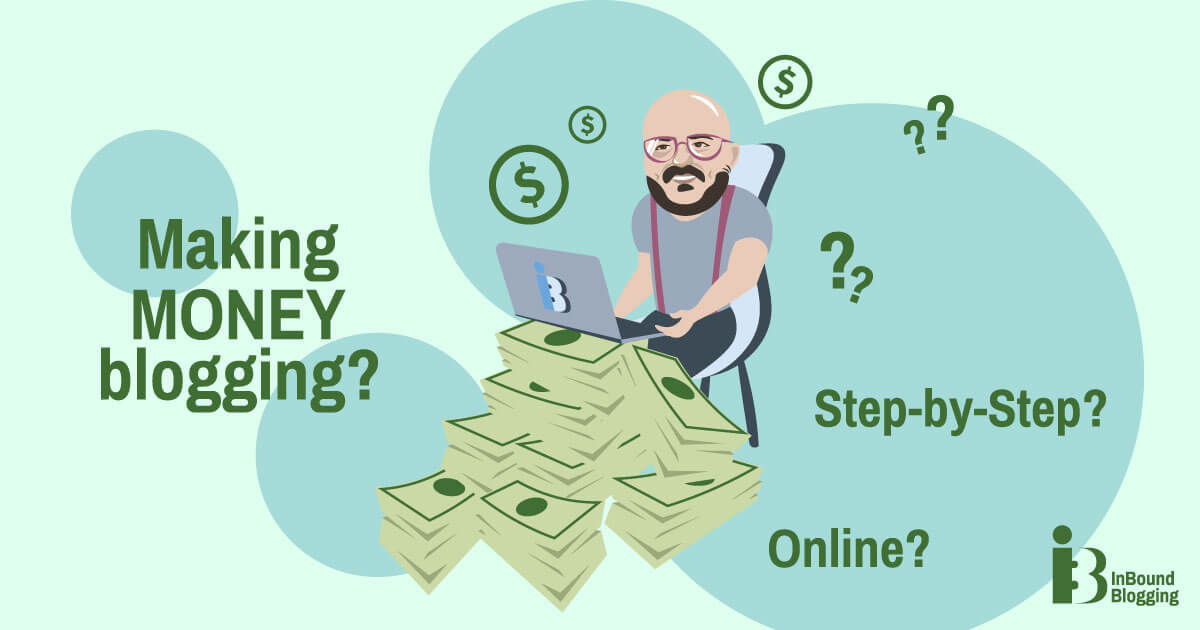It’s undeniable that email has the power to bring in high returns on investment (ROI). However, you need the right tools to hit and exceed your targets.
In this article, I take a deep dive into some of the best email marketing tools to help make your choice easier. And with the survey I carried out, you’ll instantly see which tools industry professionals lean toward.
Let’s get started.
Best Tools for Email Marketing in 2024 [Key Takeaways]
- Email marketing tools like HubSpot and Klaviyo help run campaigns better. They make tasks easier, work with other apps, show clear results, and are easy to use.
- Automation features save time by sending emails on their own. Tools like Zapier can connect many apps without requiring code.
- Some email marketing platforms offer strong analytics to track campaign success. This helps you understand your audience better and improve future messages.
- User-friendly designs in email tools make creating emails easier. Some guide you through setup or let you drag and drop elements for design purposes.
- Choosing the right tool depends on needs like automation, integration options, analysis capabilities, and ease of use.
Best Email Marketing Software: Survey Results
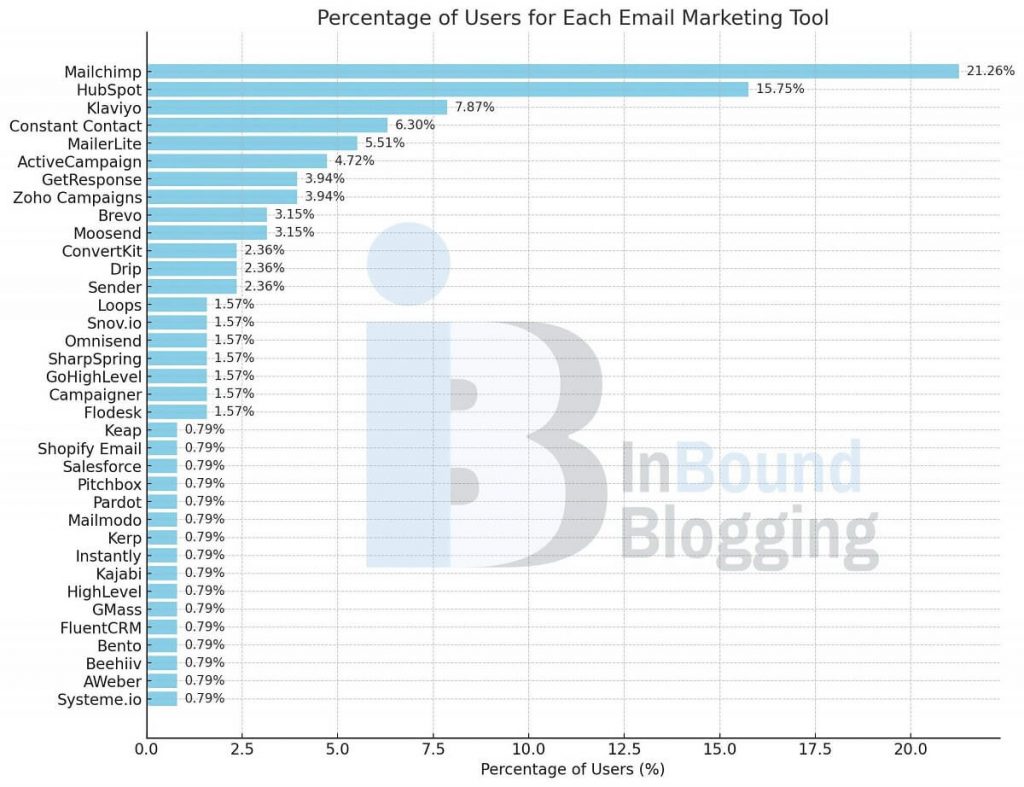
We surveyed 108 people to determine which email marketing tools industry professionals prefer. The results show that the top five email marketing platforms with their corresponding percentages are:
- Mailchimp: 21.26%
- HubSpot: 15.75%
- Klaviyo: 7.87%
- Constant Contact: 6.30%
- MailerLite: 5.51%
Let’s take a closer look at the pros and cons of the top performers.
1. Mailchimp: All-in-One Marketing Platform
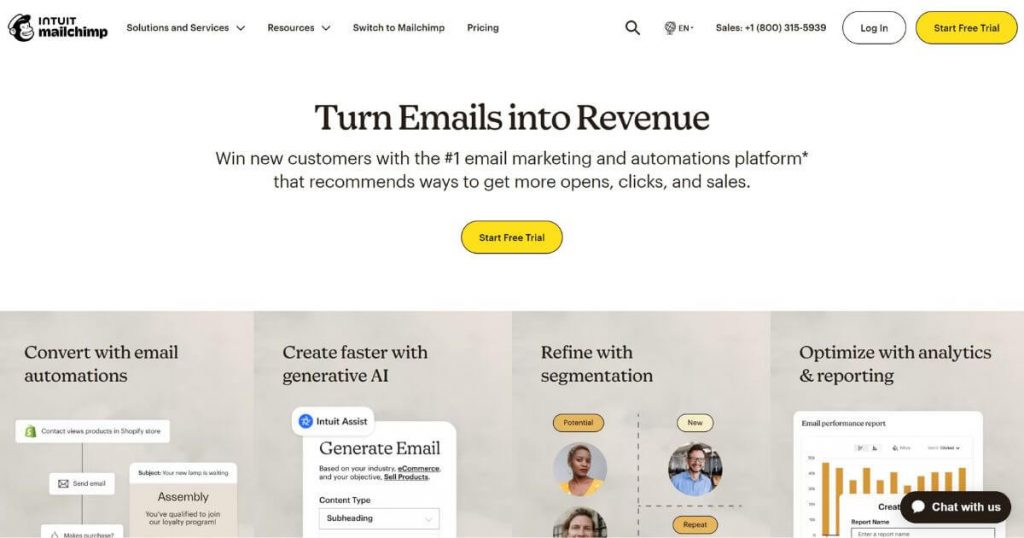
Mailchimp is an email marketing tool that simplifies campaigns, automates marketing, and connects businesses with their audience.
It features a drag-and-drop editor, customizable templates, advanced automation, segmentation, targeting, built-in analytics, and integration with third-party apps. Its features help businesses create visually appealing campaigns and grow their business.
Pros and cons of Mailchimp
| Pros | Cons |
| User-friendly drag-and-drop editor | Pricing can be steep as the subscriber list grows |
| Extensive template library | Advanced features may be less intuitive for beginners |
| Powerful automation features | Support options are limited on lower-tier plans |
| Robust analytics | |
| Seamless integrations with various apps | |
| Enhances email marketing versatility |
“Mailchimp is super easy to use and very versatile. The interface is intuitive, making it simple to design, send, and track our email campaigns. One thing we love about Mailchimp is its advanced analytics. It gives us great insights into how our audience is engaging with our marketing emails, which helps us improve our campaigns.
The automation and personalization features are also fantastic. They let us send timely and relevant emails that really connect with our audience. Whether we’re sending out recruitment updates or sharing industry insights, Mailchimp supports all our needs perfectly.
Using Mailchimp has really boosted our email marketing efforts. It’s the perfect tool for keeping in touch with our clients and prospects and making sure our messages hit the mark every time.” — Albert Kim, VP of Talent, Checkr
2. HubSpot Email Marketing Tools: Email Plus a Free CRM
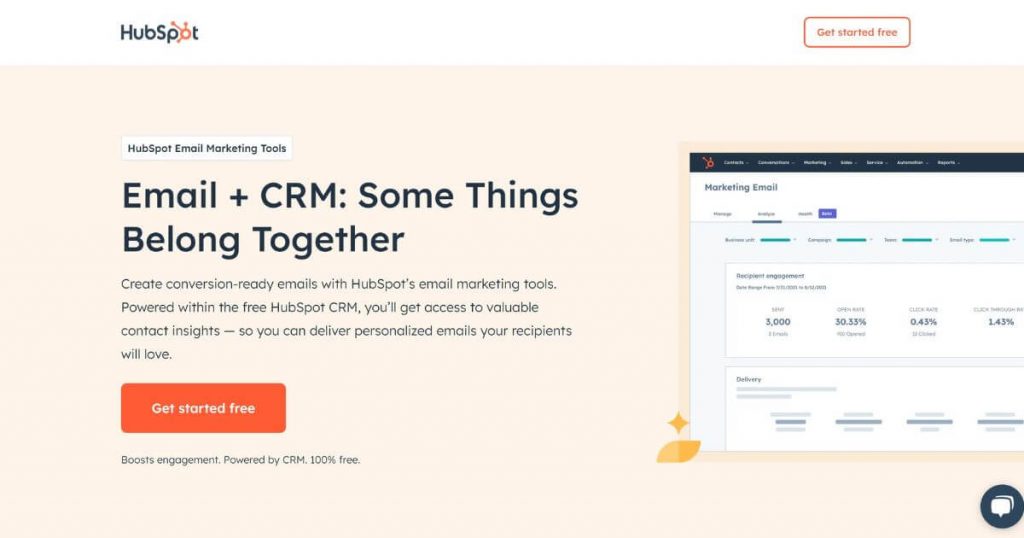
I recently dived into HubSpot Email Marketing Tools and discovered they are fantastic for email campaigns. The email and free customer relationship management (CRM) platform simplify everything—from creating emails to analyzing their performance.
With features like automation, it’s perfect for small businesses. Plus, it integrates the CRM with your email marketing flows, making it easy to target the right audience. With HubSpot, your emails will land in inboxes and not spam folders.
Furthermore, you don’t need IT or design experience to create professional-looking emails. Even better, you can get started for free, which is a total game-changer.
Pros and cons of HubSpot Email Marketing
Transitioning from exploring HubSpot Email Marketing Hub’s features, we step into a balanced viewpoint. Here’s a quick table that encapsulates the strengths and weaknesses of this platform, ensuring you get a clear snapshot of your decision-making.
| Pros | Cons |
| Comprehensive email marketing features that support a wide range of tasks | Limited email templates can restrain creative freedom |
| Excellent for segmentation, allowing for targeted campaigns | Potentially expensive upgrades can impact your budget |
| CRM integration enhances customer relationship management | A complex pricing structure might confuse new users |
| Offers annual plans with a limited free trial, making it accessible for testing | A steep learning curve can deter newcomers |
“HubSpot has been a reliable partner for us at Donorbox. Its comprehensive suite, including CRM, marketing automation, and email, has been instrumental in nurturing leads, personalizing campaigns, and measuring ROI. The platform’s deep analytics and ability to connect customer data across touchpoints have been game-changers for our growth strategy.” — Raviraj Hegde, SVP of Growth and Sales, Donorbox
3. Klaviyo: Ideal for Ecommerce Ventures
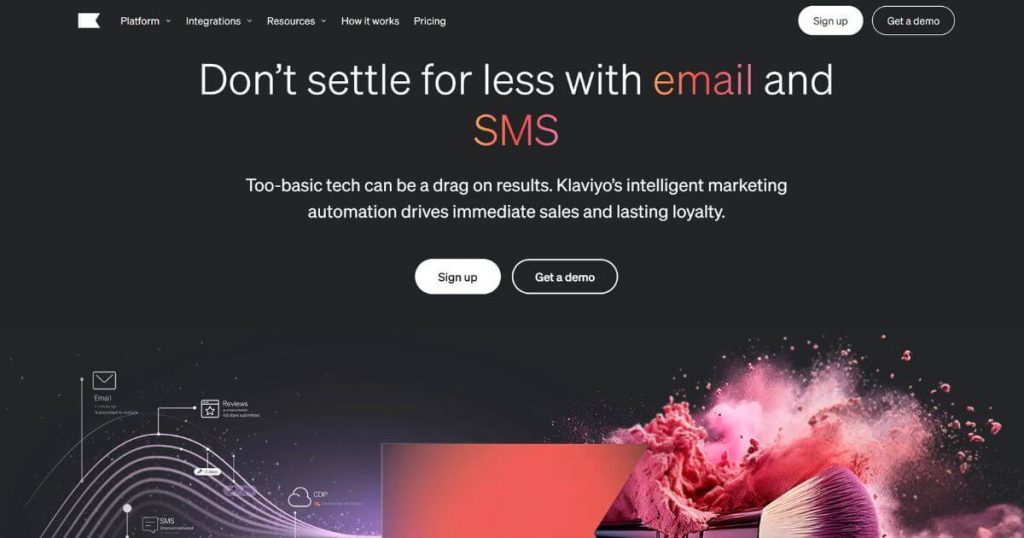
Klaviyo is perfect for ecommerce. The standout feature is the excellent reporting tools, which make it super easy to track email campaign performance.
The huge template library is a time-saver for designing emails, and the visually-oriented interface helps create appealing messages quickly. Another plus is the seamless integration with Shopify, making sales-focused email marketing a breeze.
Pros and cons of Klaviyo
Exploring Klaviyo has brought me some clear insights. Let’s dive straight into the pros and cons of this email marketing platform, perfect for ecommerce ventures.
| Pros | Cons |
| Robust reporting and analytics offer deep insights into campaign performance | Limited customer support options can be a challenge for users needing immediate help |
| An extensive template library aids in creating engaging emails with ease | Requires proficiency in email marketing, making it less ideal for beginners |
| Suitable for experienced sales teams, designed to cater to their complex needs |
“Klaviyo integrates seamlessly with our ecommerce platform, which simplifies the management of customer data and automates the synchronization of customer behaviors and interactions across our digital touchpoints. As our business grows, Klaviyo’s flexibility in handling increasing volumes of subscribers and profiles without compromising performance is invaluable.
The user-friendly interface allows our team to set up and manage email campaigns and automated flows efficiently, without needing extensive technical knowledge or external agency support.” — Clare Jones, Outreach Manager, Custom Neon
4. Constant Contact: Renowned for Customer Support
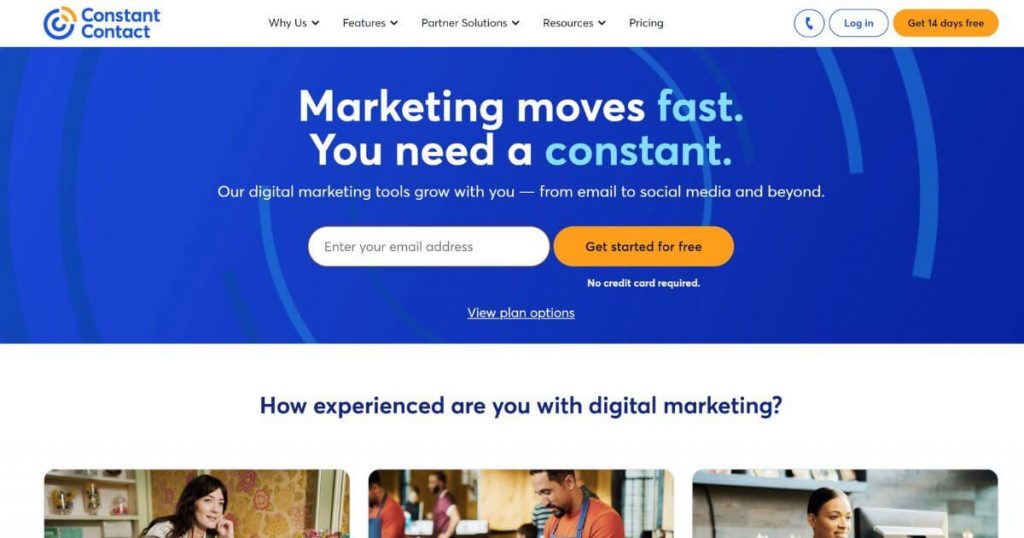
Constant Contact is a top choice for small businesses in 2024 due to its exceptional customer service, seamless integration of email, SMS, and social media marketing, user-friendly interface, and advanced automation features like AI content generation and abandoned cart reminders.
Pros and cons of Constant Contact
| Pros | Cons |
| Exceptional customer support through live phone and chat help | Limited flexibility in email templates |
| Easy-to-navigate user interface | Prices climb steeply for larger contact lists |
| Supports email, SMS, and social media marketing |
“The tool that we use is Constant Contact. There are multiple reasons, from ease of use to getting the most bang for your buck. I can always create email campaigns, automations, or integrate with other marketing platforms quickly and easily. It is truly an all-in-one platform when it comes to my email marketing.” — Kevin McLauchlin, Co-Founder, CadenceSEO
5. MailerLite: Economical Email Marketing Solution
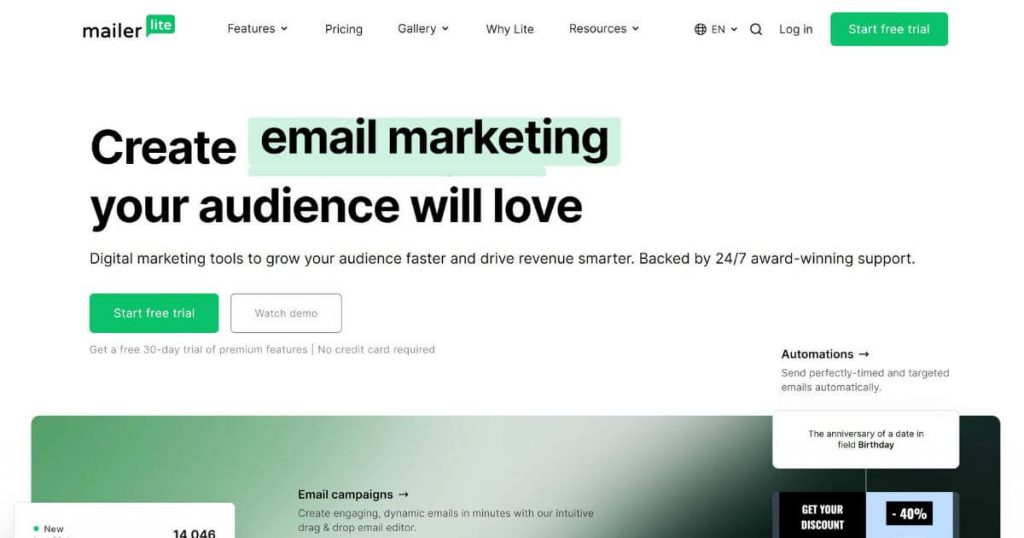
MailerLite is great for easy and affordable email campaigns. Perfect for small businesses and new marketers, it offers a free 30-day trial of premium features and a free plan for up to 1,000 subscribers and 12,000 emails monthly.
MailerLite’s dynamic content blocks and audience segmentation help craft messages that really connect. Creating appealing emails is straightforward with ready-to-use content blocks. Plus, it integrates smoothly with Zapier to automate tasks and improve your workflow, so you can focus on strategy.
Pros and cons of MailerLite
| Pros | Cons |
| Cost-effective for businesses | Fewer integrations compared to some competitors |
| Excellent segmentation for targeting emails | Inability to create templates after the free trial expires |
| Ability to add countdown timers, product details, and embed videos | |
| Ideal for both new and advanced marketers | |
| Affordable upgrades without compromising quality |
“MailerLite facilitates communication with consumers by means of straightforward automations and fundamental email campaigns. The service is known for its minimalist approach, which emphasizes the provision of only the most essential email marketing tools.
The free account allows for the storage of up to 1,000 contacts and the transmission of up to 12,000 emails per month, making it one of the best free email marketing tools available.
It includes the majority of the features of the paid plans (which are contingent upon the number of subscribers), but it does not include personal branding options or the advanced capabilities that enterprises and professional companies may require, such as live chat support, a custom HTML editor, promotion popups, or A/B testing.” — Alex Taylor, Head of Marketing, CrownTV
6. ActiveCampaign: Leader in Marketing Automation
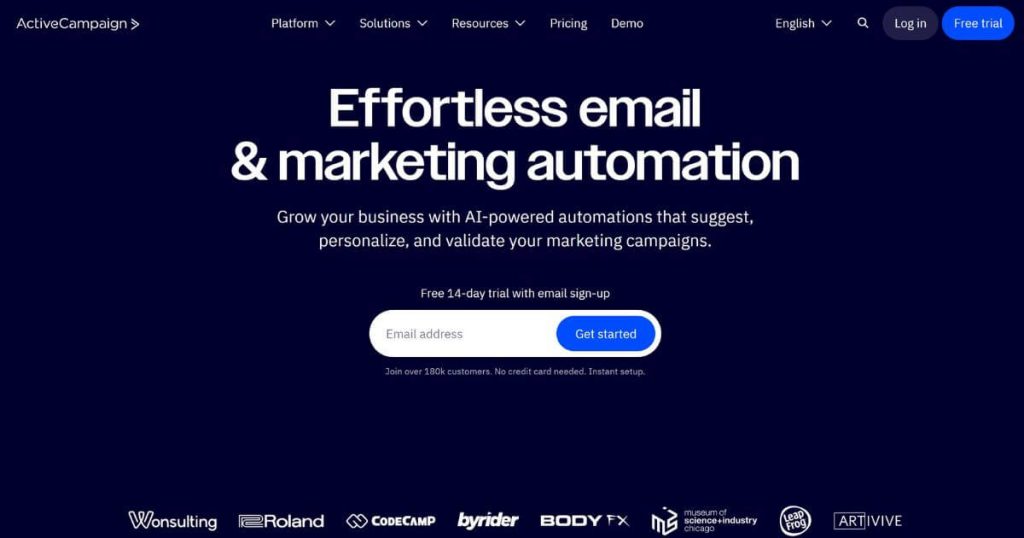
ActiveCampaign is fantastic for email management with its clever automation that reaches the right people at the right time. ActiveCampaign excels in marketing automation for small businesses, covering email, SMS, and social media.
Plus, it integrates smoothly with CRM and ecommerce systems, and its spam detector feature ensures your emails avoid spam filters.
Pros and cons of ActiveCampaign
| Pros | Cons |
| Excels in marketing automation | Email design can be somewhat inflexible |
| Perfect for small businesses | Limited template adaptability |
| Consistently reliable email deliverability | Becomes costlier as the contact list expands |
| Employs a Spam Check system to avoid spam folders | More contacts equate to higher expenses |
| Effective third-party integrations | |
| Packed with features for email, SMS, and social media campaigns |
7. GetResponse: For Marketing Automation
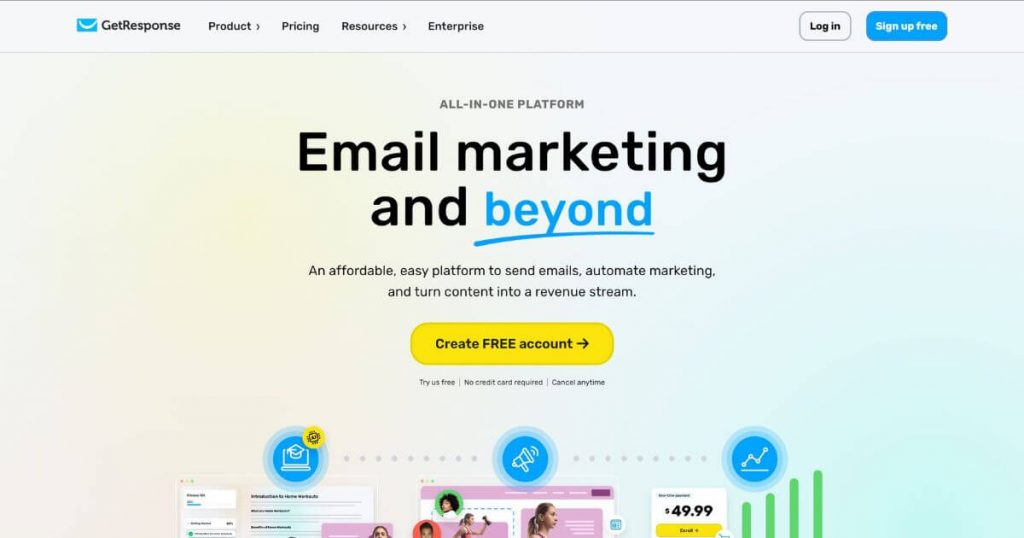
GetResponse is an email marketing tool that streamlines marketing efforts and boosts engagement for businesses. It offers email automation, landing page creation, and webinar hosting, enhancing digital marketing strategies.
The platform also supports creating targeted landing pages, sales funnels, webinar hosting, and robust analytics. Its integration with third-party applications further extends its capabilities, making it a versatile solution for managing multi-channel marketing campaigns.
Pros and cons of GetResponse
| Pros | Cons |
| Comprehensive feature set including email automation, landing page creation, and webinar hosting | Occasional lags in customer support |
| User-friendly interface with drag-and-drop editors | A somewhat steep learning curve to master all features |
| Robust analytics | It may not be cost-effective for smaller businesses or those with simpler needs |
| Seamless third-party integrations | |
| Versatile toolkit for multi-channel campaigns |
“I prefer GetResponse for email marketing. GetResponse’s automation features allow us to set up targeted drip campaigns to nurture leads. For a home services client, we created a series of automated welcome emails, resulting in a 54% increase in sales conversions within the first month.
GetResponse meets our budget and needs with affordable plans, high deliverability, and open rates. Last year, we had a 0.03% spam complaint rate across over 2 million emails. Analytics provide the insights we need to optimize campaigns, and the simple drag-and-drop builder lets us create engaging emails quickly.” — Robert P. Dickey, President and CEO, AQ Marketing
8. Zoho Campaigns: Seamless Integration With the Zoho Ecosystem
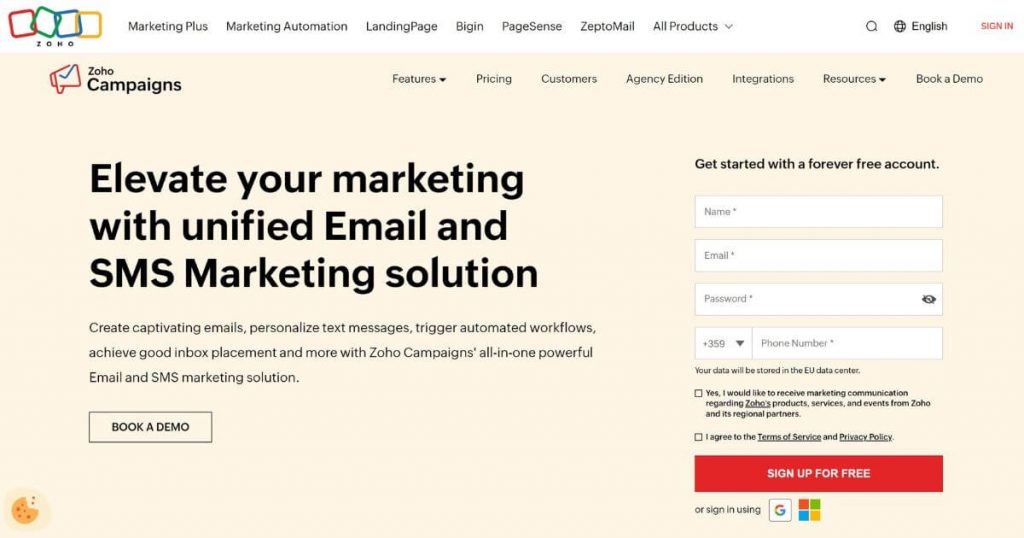
Zoho Campaigns is an email marketing tool designed for businesses to create engaging campaigns and manage customer relationships.
It features a user-friendly editor, advanced automation workflows, robust segmentation, list management, and detailed analytics. It also integrates with other Zoho products and third-party applications for seamless marketing synchronization.
Pros and cons of Zoho Campaigns
| Pros | Cons |
| Intuitive drag-and-drop editor | Some users find the learning curve a bit steep |
| Robust automation features | Occasional technical glitches |
| Seamless integration with other Zoho products | |
| Detailed analytics and reporting tools | |
| Affordable pricing | |
| Streamlines email marketing efforts |
“Zoho Campaigns is an invaluable tool for our email marketing efforts. What sets it apart is its unique integration with Zoho CRM, which allows for seamless synchronization of customer data and campaign performance.
This feature enables us to create highly targeted and personalized email campaigns based on detailed customer insights. For instance, we can easily segment our audience based on their interactions with previous campaigns, website behavior, or purchase history stored in the CRM.
This level of personalization has significantly improved our open rates and click-through rates. Moreover, the real-time tracking of campaign performance directly within the CRM helps us quickly identify hot leads and follow up promptly.” — Tristan Harris, Demand Generation Sr. Marketing Manager, Thrive Internet Marketing Agency
9. Brevo: Unlimited Contact Management

Brevo (formerly Sendinblue) is a versatile tool that allows you to manage unlimited contacts, streamline your marketing efforts, and automate tasks. It includes a complete CRM system, allowing you to organize sales meetings, handle calls, manage chat interactions, and track deals. Brevo also offers templated automation flows for various goals, allowing you to engage new subscribers and follow up on leads.
Pros and cons of Brevo
| Pros | Cons |
| Easy-to-use interface | No landing page options on the free plan |
| Impressive email builder | Costs can increase when buying additional credits |
| Supports SMS and WhatsApp marketing | |
| Versatile choice for reaching audiences across multiple platforms |
“What makes Brevo stand out is its advanced personalization features, which allow me to create highly tailored email campaigns. I was motivated to adopt this tool for my email marketing strategy because it helps me connect with my audience on a more personal level.
Brevo’s dynamic content capabilities enable me to customize email content based on individual subscriber behavior and preferences. This level of personalization has significantly improved my open and click-through rates.
Moreover, Brevo’s real-time reporting and analytics provide valuable insights into how my campaigns are performing, allowing me to make informed decisions. Its comprehensive support and resources also ensure that I can quickly resolve any issues and stay updated on best practices.” — Shawn Plummer, CEO, The Annuity Expert
10. Moosend: An Intuitive Drag-and-Drop Email Editor
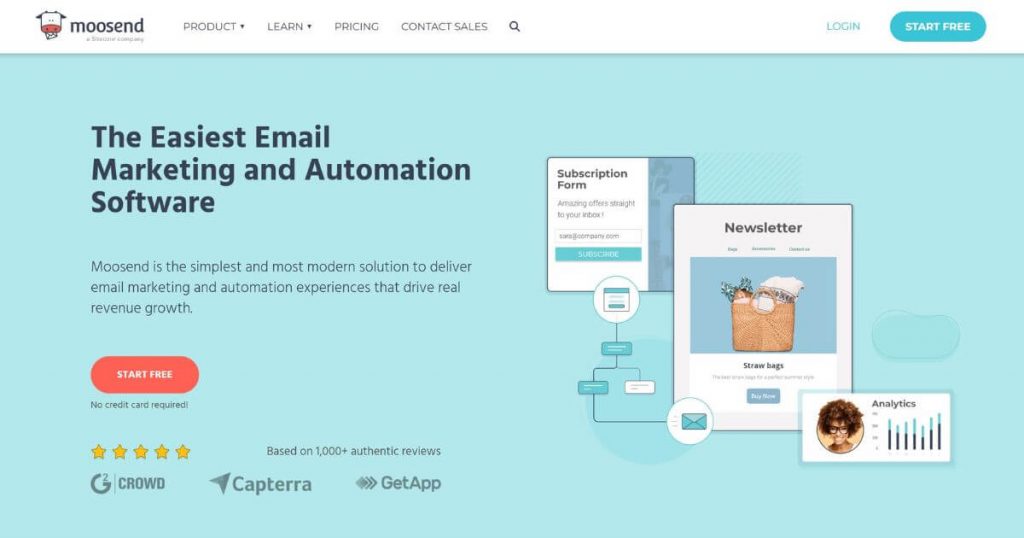
Moosend is an email marketing platform that enhances customer engagement and conversions by automating campaigns and providing detailed analytics and segmentation capabilities.
Its drag-and-drop editor, advanced automation workflows, and built-in A/B testing help businesses create visually appealing, responsive emails and make data-driven decisions.
Pros and cons of Moosend
| Pros | Cons |
| Intuitive drag-and-drop editor | Limited integration options compared to other platforms |
| Pre-designed templates make email creation easy | Occasional delays in customer support response times |
| Advanced email marketing automation for personalized customer journeys | |
| Boosts customer engagement | |
| User-friendly and powerful functionality |
“Moosend offers an intuitive interface and affordable pricing, making it perfect for small- to medium-sized businesses. I use Moosend for my email marketing because it allows me to efficiently scale my efforts without breaking the bank. The user-friendly design makes it easy for anyone on my team to navigate and utilize its features effectively.
What I appreciate the most is the drag-and-drop editor, which enables me to create visually appealing emails without any coding knowledge. This ensures that my campaigns always look professional and engaging, helping to capture the audience’s attention effectively.” — Leigh McKenzie, Community Advocate, Traffic Think Tank
11. ConvertKit: Features Exclusively for Creators
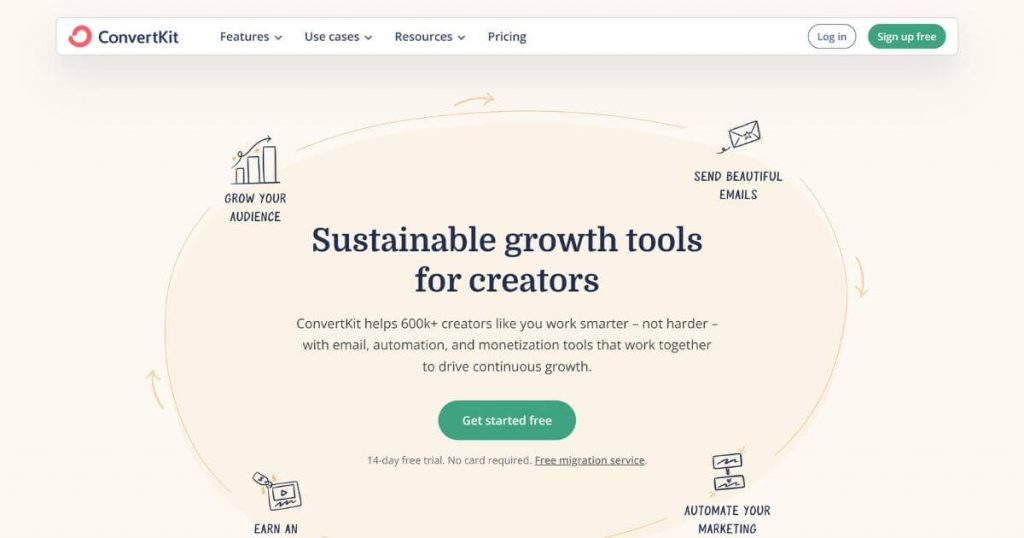
ConvertKit streamlines your email marketing efforts. This user-friendly platform allows you to create visually appealing email campaigns, automate workflows, and manage subscribers with ease.
It integrates seamlessly with your website and other tools, helping you to engage your audience and grow your business effectively. ConvertKit truly simplifies email marketing.
Pros and cons of ConvertKit
| Pros | Cons |
| User-friendly interface | Higher pricing for larger subscriber counts |
| Excellent automation features | Basic reporting compared to some competitors |
| Seamless integration with various platforms | Learning curve for beginners in automation |
| Great customer support | |
| Landing pages and forms included |
12. Drip: To Guide Prospects Through the Sales Funnel

Drip is an email marketing tool designed for ecommerce businesses, offering advanced automation and personalized communication to drive customer engagement and sales.
Its user-friendly interface and robust analytics enable businesses to create targeted campaigns and optimize marketing efforts.
Key features include advanced segmentation, an intuitive visual workflow builder, seamless integration with platforms, customizable forms, and robust A/B testing capabilities.
Pros and cons of Drip
| Pros | Cons |
| Advanced segmentation and automation capabilities | Pricing structure can be high for smaller businesses or startups |
| Highly personalized and targeted communication | May not offer as many advanced customization options as specialized tools |
| Significant improvement in customer engagement and conversion rates | |
| Seamless integration with popular ecommerce platforms | |
| Extensive analytics for valuable insights | |
| User-friendly interface and visual workflow builder |
“We’re using Drip. We love how easy it is to build workflows, whether it’s welcome emails to new subscribers or targeted messages based on user behavior.” — Roxana Motoc, Head of Marketing, SocialBee
13. Sender: Simplicity and Effectiveness
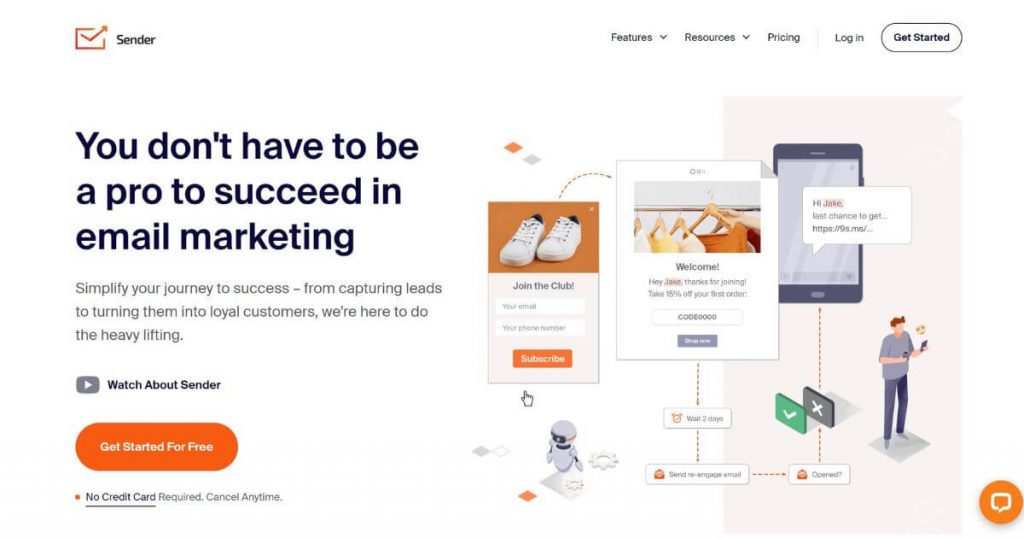
Sender’s email marketing tool is all about making your life easier. It’s super user-friendly, so you don’t need to be technically savvy to get started.
Plus, it packs powerful automation and segmentation features to help you reach the right audience with minimal effort. With Sender, you can create professional-looking campaigns without breaking a sweat, and the best part? It’s designed to deliver great results without the hefty price tag.
Pros and cons of Sender
| Pros | Cons |
| User-friendly interface, easy forbeginners | Limited advanced features for large enterprises |
| Strong automation and segmentation capabilities | Reporting features could be more detailed |
| Affordable pricing, including a freeplan | Template variety may be limited compared to competitors |
| High deliverability rates | Customer support response times may vary |
| Integrations with popular platforms | Customization options can be somewhat basic |
“As an affiliate marketing business, I need to keep my monthly expenses low and lean to be able to make a living. Therefore, as an email marketing software, I use Sender because it is one of the most affordable email marketing tools on the market while still retaining good automation features. Plus, the brand runs specials regularly so you can get the yearly subscription even with a 20% discount. Their customer service via chat or e-mail is also pretty good, and their response time is fast.” — Simona Paganetto, Founder, I’m Plastic Free
14. Loops: Simplicity and User-Friendliness
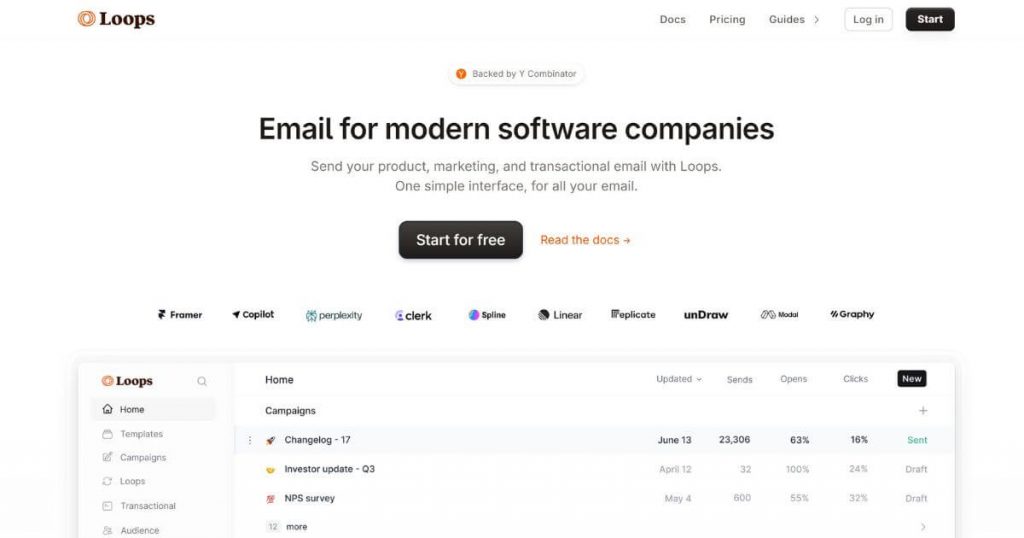
Loops is a modern email marketing tool that simplifies creating engaging campaigns and connecting with audiences. It features a drag-and-drop editor, automation tools, robust analytics, list management, segmentation, and seamless integration with other platforms for efficient business growth.
Pros and cons of Loops
| Pros | Cons |
| Intuitive drag-and-drop editor | Relatively new and may lack some advanced features for seasoned marketers |
| Smart email marketing automation tools | It may take time to discover all its capabilities |
| Robust analytics for tracking performance | |
| Easy list management | |
| Seamless integrations | |
| User-friendly, great for beginners |
“Loops excels compared to other email marketing solutions primarily because of its manual dispatch option, which offers a high level of control over campaign timing and execution. This feature allows me to send emails at precisely the right moment, ensuring they align with specific events or promotional activities. The flexibility of manually dispatching emails helps me tailor my messaging to the audience’s immediate needs and preferences.
I chose Loops for this capability because it lets me respond quickly to market changes and customer behavior, optimizing engagement. Furthermore, this option provides the opportunity to review and tweak campaigns before they go live, reducing the risk of errors.” — Thomas Medlin, Co-founder, JumpMD
15. Snov.io: Boosting Outreach and Generating Quality Leads
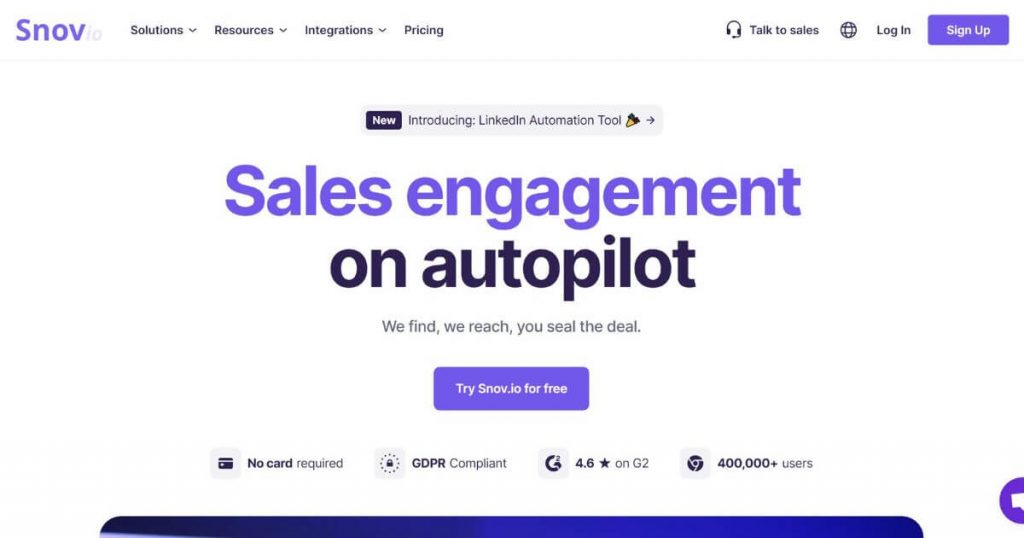
Snov.io is an all-in-one growth hacking and email automation platform tailored for lead generation and outreach. With its powerful email finder, verified email lists, and seamless CRM integration, it simplifies contact management.
Its email drip campaigns and robust analytics ensure effective engagement and performance tracking. Ideal for sales professionals and marketers, Snov.io combines data enrichment and lead verification to optimize your outreach strategy and drive business growth.
Pros and cons of Snov.io
| Pros | Cons |
| Comprehensive email-finding tools | It can be complex for beginners |
| Reliable email verification tool to reduce bounces | Higher-tier plans can be pricey |
| Data enrichment for better lead quality | The free plan has limited features and credits |
| Convenient Chrome extension | |
| Effective email drip campaigns for automation |
16. Omnisend: Optimal for High-Volume Campaigns
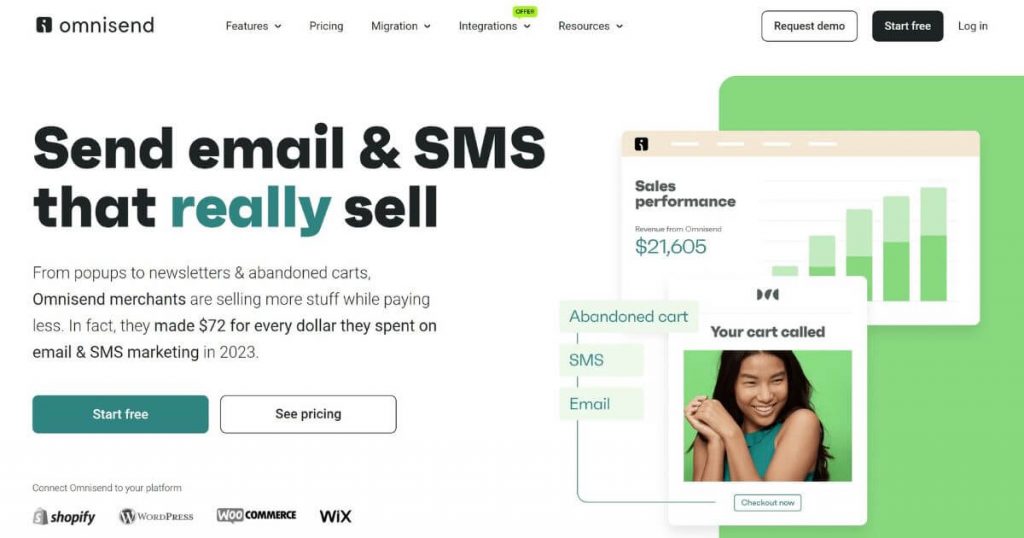
Omnisend is your go-to for big message blasts. It’s built to handle loads of emails. For just $16 a month on the Standard plan, you can send up to 6,000 emails.
It’s a powerhouse for email marketing automation with stellar ecommerce features that handle online store management and large inventories. Plus, it ensures your emails hit customers’ inboxes when they’re most likely to buy. The best part? Their 24/7 live chat support has your back anytime you need help.
Pros and cons of Omnisend
Exploring Omnisend’s strengths and weaknesses gives us a clear perspective on what it offers for email marketing campaigns.
| Pros | Cons |
| High-volume campaign capabilities | Limited free use |
| Advanced automation features | Feature richness may require a learning curve |
| Seamless integration with ecommerce platforms | Can be challenging for beginners |
| Comprehensive analytics and reporting tools | |
| User-friendly interface |
“We essentially rely on Omnisend for our email marketing. It has an easy-to-understand user interface that’s honestly such a breeze to navigate and powerful automation features that just make it easy to create personalized campaigns—strengthening our connection with readers.
Omnisend’s segmentation tools are particularly impressive, in my opinion, allowing us to target specific audience groups based on their behaviors and preferences, making sure that our content hits home, which then boosts our open and click-through rates.
The detailed analytics also give us a lot of great insights into our campaign performance, doing us a big favor by helping continually refine our strategies. Plus, its seamless integration with ecommerce platforms and social media channels simplifies our marketing efforts.” — Dane Nk, Founder, That VideoGame Blog
Other Email Marketing Platforms Worth Mentioning
Apart from the tools mentioned above, there are more that made it on my list of the best email marketing tools worth mentioning. SharpSpring, Campaigner, Mailmodo, AWeber, and Campaign Monitor stand out among these. Let’s explore each one in more detail below.
17. SharpSpring: Ideal for Lead Scoring
SharpSpring is a marketing automation platform that enhances businesses’ marketing efforts and sales growth. It offers email marketing, CRM, and social media management features, allowing users to create personalized campaigns and track their effectiveness.
It integrates with third-party applications, streamlining workflows and improving marketing efficiency. SharpSpring’s user-friendly design, advanced segmentation capabilities, automation workflows, and comprehensive analytics help email marketing teams monitor campaign performance and refine strategies.
Pros and cons of SharpSpring
| Pros | Cons |
| Comprehensive all-in-one platform | Learning curve for newcomers |
| Includes email marketing, CRM, social media management, and landing page creation | Limited customization options for advanced users |
| User-friendly interface with a drag-and-drop functionality | Occasional inconsistent customer support experiences |
| Robust automation capabilities for sophisticated workflows and lead nurturing | |
| Seamless integration with numerous third-party applications | |
| Cost-effective relative to similar tools on the market |
“We use SharpSpring for our email marketing because it seamlessly aligns with our overall marketing goals. Its robust CRM and email automation workflow enable us to send personalized messages to the right audience at the right time, boosting engagement and conversions. With features like form creation and refined, rule-based prospect lists, SharpSpring supports our email nurture, drip, and targeted campaigns.
Additionally, the tool also offers comprehensive analytics that help us continually improve our campaigns. The platform’s social media management, landing page creation, and dynamic forms have streamlined our marketing efforts and enhanced team collaboration. SharpSpring’s cost-effectiveness and powerful capabilities make it our preferred choice for email marketing.” — Lauren Parr, Cofounder and Product Director, RepuGen
18. Campaigner: Advanced Tools for Skilled Email Marketers
For $79.95/month, you get unlimited emails through Campaigner’s ecommerce plan, perfect for frequent outreach. The image library helps craft eye-catching emails, and survey tools let you understand your audience better.
With marketing automation and A/B testing, Campaigner ensures quality campaigns. Plus, its RESTful API and social media integration keep everything connected, and 24/7 phone support is a great bonus!
Pros and cons of Campaigner
| Pros | Cons |
| Allows you to combine email and SMS marketing | Complex for newbies |
| A/B testing | Steep pricing model |
| Strong marketing automation | Limited template flexibility |
| Impressive email deliverability rates | |
| Effective spam checkers | |
| Strong integration capabilities |
“I mainly rely on Campaigner for our email marketing at our company, as I find that it does wonders in both segmentation and automation. With it, we’re able to target our agenda precisely based on what our users are doing and what they like, which really helps boost engagement and drive conversions.
With the information and data Campaigner gives us, we’re able to accumulate clear insights into how our campaigns are performing, so we can tweak our strategies as needed.” — Adam Wright, Founder and CEO, Human Tonik
19. Mailmodo: Ability to Create Interactive Emails
Mailmodo is an email marketing tool that enables businesses to create interactive, engaging campaigns.
It features AMP emails, a drag-and-drop editor, advanced automation workflows, robust analytics, and seamless integrations with third-party applications, enhancing engagement and driving conversions.
Pros and cons of Mailmodo
| Pros | Cons |
| Enables interactive AMP emails for higher engagement | Newer platform with potential growing pains |
| User-friendly drag-and-drop editor | Occasional bugs |
| Advanced automation features | Limited advanced features compared to established tools |
| Robust analytics for insightful performance data | |
| A fresh and engaging approach to email marketing | |
| Seamless integrations with other tools |
“We use Mailmodo to send our newsletters, lead nurture emails, and onboarding emails. We primarily use it for its interactive elements, like feedback forms, which allow us to understand how the person feels about our lead magnet or product.
We also have set up a referral form there, where our audience can refer our newsletter to people they know all inside the email. They have some really good interactive elements that help reduce friction and get more email engagement from readers.” — Jyothiikaa Moorthy, Product Marketing Manager, Mailmodo
20. AWeber: Comprehensive Autoresponder Functionality
AWeber is an email marketing platform that aids businesses in creating, sending, and analyzing email campaigns for customer engagement and growth. It features a drag-and-drop builder, an extensive template library, automation, list management, analytics, integration, A/B testing, sign-up forms, and mobile-responsive designs.
Pros and cons of AWeber
| Pros | Cons |
| User-friendly drag-and-drop builder | The interface feels a bit dated |
| Extensive template library | Pricing can be steep for smaller businesses |
| Automation and segmentation features for personalized campaigns | Integration options are not as extensive as some competitors |
| Reliable deliverability rates | |
| Ensures emails land in inboxes, not spam folders |
“AWeber’s automation tools let me set up targeted email journeys for clients that drive results. For an ecommerce store, we created an abandoned-cart sequence that generated significant sales in two weeks.
I choose AWeber for its high deliverability, open rates, and affordable plans. Last year, I had under 0.05% spam complaints across three million emails. AWeber’s analytics provide insights to optimize campaigns, and the WYSIWYG editor lets me build engaging emails fast.” — Randy Speckman, CEO, Randy Speckman Design
21. Campaign Monitor: Superior in Integration Capabilities
Great for small businesses, the Campaign Monitor tool combines email, SMS, and social media marketing, all with an easy what-you-see-is-what-you-get (WYSIWYG) interface that gets your campaigns up and running fast.
It integrates smoothly with CRM and ecommerce systems, automates marketing tasks, and has a spam-fighting feature to ensure your messages hit the mark. With plenty of professional email templates and 24/7 phone support, it’s a solid choice, although I wish live chat was available at all levels.
Pros and cons of Campaign Monitor
| Pros | Cons |
| User-friendly tools | Changing email designs can be tricky due to limited template choices |
| Multiple ways to connect with other programs | Higher costs with larger contact lists |
| High email deliverability | Can’t manage ads or messages across different channels from one place |
| Features for emailing, texting, and social media | May set limits for fast-growing businesses or those handling a mix of online chats and emails |
| Works well with CRM and online store systems |
Email Marketing Strategy Enhancements
To make your email campaigns better, focus on changing them based on what people want. Keep talking to users and check if your emails work well. This keeps everyone happy and makes emails much more fun to read.
- Segment lists by user intent: Split email lists based on users’ needs, using tools like HubSpot to identify browsing and buying habits. Analyze actions, such as signing up but not buying, to send targeted emails. This ensures engaging content without boredom or annoying messages.
- Engage users at every step: Utilizing automation features, segmenting lists by intent, employing autoresponders, and using platforms like MailerLite and Loops simplify user engagement. Choose marketing tools that allow precise targeting and personalization at every stage, from welcoming new subscribers to re-engaging old customers through strategic campaigns guided by analytic insights.
- Analyze campaign effectiveness: Klaviyo and Omnisend are email campaign tools that provide detailed analytics for assessing campaign performance. They help identify which emails drive sales and enable quick adjustments. By analyzing email marketing KPIs, such as open rates, click-through rates, and sales, marketers can identify successful campaigns and adjust strategies for improved results.
Conclusion
Finding the right email marketing tool can genuinely revolutionize your campaigns. With resources such as HubSpot, Klaviyo, and Omnisend available, you gain automation, integration, analytics, and simplicity—all in one location.
From substantial volume blasts to specialized ecommerce plans, there exists a perfect platform to fulfill such requirements. Resources like MailerLite provide cost-effectiveness without sacrificing features, while Campaign Monitor impresses with its extensive integration potential.
Eventually, by selecting the most suitable tool aligned to your unique objectives—be it improving user interaction or refining your marketing approach—you can guarantee your campaign reach and connect with your audience more efficiently.
FAQ
How can automating my emails improve my business?
Automating your emails with top-rated software allows you to streamline your processes, freeing up time for other tasks. Use email marketing automation to ensure consistent communication with your audience, boosting engagement rates.
Can email marketing tools help me manage large lists of addresses?
Yes. The best email marketing services include powerful tools to efficiently handle vast numbers of email addresses. They aid in segmenting audiences based on behavior or preferences, making personalized outreach a breeze.
Is it expensive to implement an advanced email marketing system in my business?
Not necessarily. Many leading systems offer affordable plans based on usage or the size of the subscriber list. Some even provide free tiers with limited features. However, investing in effective communication channels often pays off by increasing customer engagement and sales.
Does email marketing software require a technical team to operate them?
No. Most popular email marketing tools have intuitive interfaces designed with non-technical users in mind. Drag-and-drop builders make it simple to create visually appealing emails, while pre-built templates speed up the process further.


